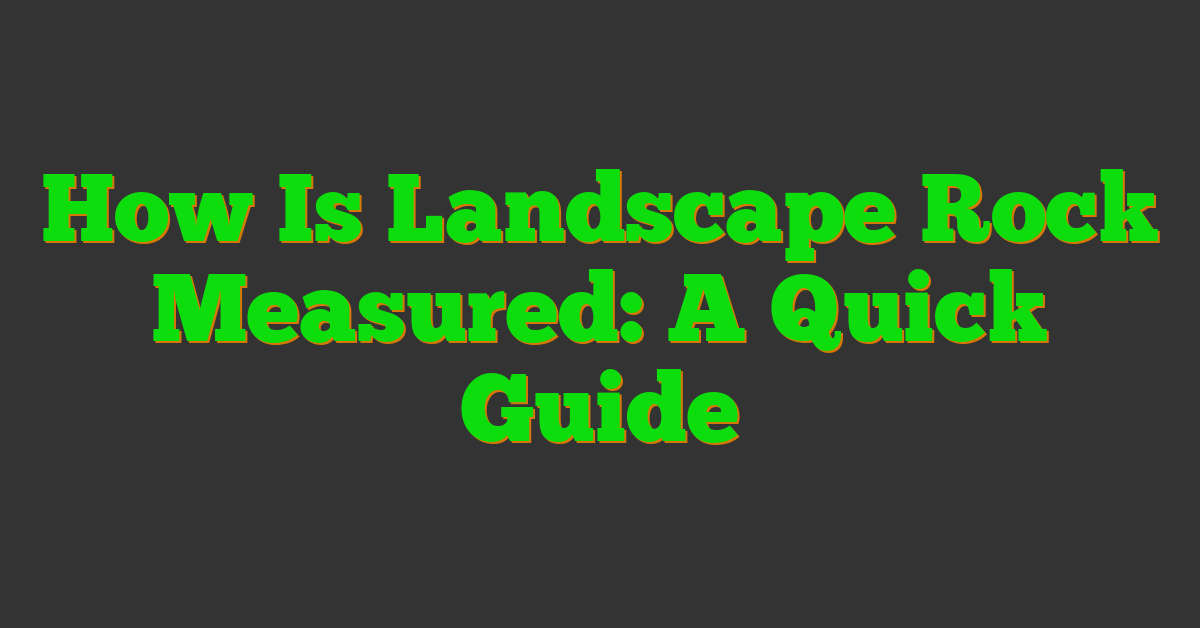If you’re planning a landscaping project, you’ll need to know how to measure landscape rock. Proper measurement is crucial to ensure that you have enough rock to complete your project without overspending or running out of materials. There are several factors to consider when measuring landscape rock, including the type of rock, the shape of the area to be covered, and the depth of the rock layer.

Understanding Landscape Rock Measurements is an important first step in determining how much rock you’ll need. Landscape rock is typically measured in cubic yards, which is a measure of volume. One cubic yard is equal to 27 cubic feet. To calculate the amount of rock you’ll need, you’ll need to measure the length, width, and depth of the area to be covered. This will give you the total cubic feet of rock required. You can then divide this number by 27 to get the total cubic yards of rock you’ll need to order.
Key Takeaways
- Landscape rock is typically measured in cubic yards, which is a measure of volume.
- To calculate the amount of rock you’ll need, you’ll need to measure the length, width, and depth of the area to be covered.
- The shape of the area, the type of rock, and the depth of the rock layer are all important factors to consider when measuring landscape rock.
Understanding Landscape Rock Measurements

https://www.youtube.com/watch?v=I3OIO08i_Uo&embed=true
If you’re planning to use landscape rock in your yard, it’s essential to know how to measure it accurately. This section will cover the basic measurement concepts and units of measurement you need to know.
Basic Measurement Concepts
Before you start measuring your landscape rock, you need to understand a few basic measurement concepts. The three essential concepts are depth, length, and width.
- Depth: The depth is the distance from the surface of the ground to the top of the rock layer. It is measured in feet.
- Length: The length is the distance from one end of the rock layer to the other. It is measured in feet.
- Width: The width is the distance from one side of the rock layer to the other. It is measured in feet.
Units of Measurement
The units of measurement you’ll use to measure landscape rock depend on the area you’re covering. Here are the most common units of measurement:
- Square Footage: Square footage is the area of a surface measured in square feet. To measure the square footage of the area you want to cover, multiply the length by the width of the area.
- Cubic Feet: Cubic feet is the volume of a space measured in cubic feet. To measure the cubic feet of landscape rock you need, multiply the square footage of the area by the depth of the rock layer.
- Cubic Yards: Cubic yards is the volume of a space measured in cubic yards. To convert cubic feet to cubic yards, divide the cubic feet by 27. One cubic yard is equal to 27 cubic feet.
- Total Area: Total area is the total area you want to cover with landscape rock. It is measured in square feet.
To determine the amount of landscape rock you need, you’ll need to calculate the square footage of the area you want to cover and the depth of the rock layer. Then, you can use a landscape rock calculator to determine the cubic feet or cubic yards of rock you need. Remember to double-check your measurements to ensure you order the correct amount of rock.
Calculating Landscape Rock Quantity
https://www.youtube.com/watch?v=QB-V9xYPjy0&embed=true
When it comes to landscaping projects, determining the amount of landscape rock needed is an essential step. This section will help you understand the process of calculating landscape rock quantity.
Determining Area and Volume
Before you calculate the amount of landscape rock required, you need to determine the area and volume of the project. To do this, you need to measure the length, width, and depth of the area you want to cover with landscape rock. Once you have these measurements, you can use the following formula to calculate the volume:
Volume = Length x Width x Depth
If you want to convert the volume to cubic yards, you can divide the result by 27, as there are 27 cubic feet in one cubic yard.
Using a Landscape Rock Calculator
If you want to make the calculation process easier, you can use a landscape rock calculator. These online tools allow you to enter the dimensions of your project and calculate the amount of landscape rock required. For example, HomeAdvisor’s landscape rock calculator allows you to enter the area and depth of your project, and it will provide you with an estimate of the amount of landscape rock needed.
Real-World Calculation Examples
Here are some real-world calculation examples to help you understand the process better:
- If you have a project that is 10 feet long, 5 feet wide, and 2 inches deep, you can calculate the volume as follows:
Volume = 10 x 5 x (2/12) = 8.33 cubic feet
To convert this to cubic yards, you can divide the result by 27:
Volume = 8.33 / 27 = 0.31 cubic yards
- If you have a project that is 20 feet long, 10 feet wide, and 4 inches deep, you can calculate the volume as follows:
Volume = 20 x 10 x (4/12) = 66.67 cubic feet
To convert this to cubic yards, you can divide the result by 27:
Volume = 66.67 / 27 = 2.47 cubic yards
By following the steps and formulas outlined in this section, you can calculate the amount of landscape rock needed for your project accurately.
Types of Landscape Rocks and Their Measurements
https://www.youtube.com/watch?v=Yn69S6yEW64&embed=true
Landscape rocks are available in various types and sizes. Each type of rock has its own unique properties and uses. When measuring landscape rocks, you will need to consider the type of rock you are using, the size of the area to be covered, and the depth of the rock.
Gravel and Pea Gravel
Gravel and pea gravel are popular choices for landscaping due to their affordability and versatility. Gravel is available in different sizes, ranging from 1/4 inch to 2 inches in diameter. Pea gravel is smaller in size and is typically 1/4 inch in diameter.
When measuring gravel or pea gravel, you will need to determine the length, width, and depth of the area to be covered. To calculate the cubic feet of gravel needed, multiply the length by the width by the depth (in feet). Divide the result by 27 to convert cubic feet to cubic yards.
Lava Rock and River Rock
Lava rock and river rock are natural stones that can add texture and color to your landscaping. Lava rock is typically available in shades of red and black, while river rock comes in a range of colors, including brown, tan, and gray.
When measuring lava rock or river rock, you will need to determine the length, width, and depth of the area to be covered. To calculate the cubic feet of rock needed, multiply the length by the width by the depth (in feet). Divide the result by 27 to convert cubic feet to cubic yards.
« Are Landscaping Expenses Tax Deductible? Exploring Tax Write-Offs for Your Outdoor Space How Are Landscaping Rocks Made: A Quick Guide »
Crushed Stone and Decomposed Granite
Crushed stone and decomposed granite are popular choices for walkways, patios, and driveways due to their durability and low maintenance. Crushed stone is available in different sizes, ranging from 1/4 inch to 2 inches in diameter. Decomposed granite is smaller in size and is typically 1/4 inch in diameter.
When measuring crushed stone or decomposed granite, you will need to determine the length, width, and depth of the area to be covered. To calculate the cubic feet of rock needed, multiply the length by the width by the depth (in feet). Divide the result by 27 to convert cubic feet to cubic yards.
In summary, measuring landscape rocks is an important step in any landscaping project. By determining the type of rock you need and the size of the area to be covered, you can estimate the quantity required and plan accordingly.
Estimating Rock Quantities for Specific Projects
https://www.youtube.com/watch?v=kTnIJznzFbI&embed=true
When planning your landscaping projects, it’s important to estimate the amount of rock you’ll need to complete the job. By doing so, you can save money and time by ordering the right amount of rock and avoiding unnecessary trips to the store. Here are some guidelines to help you estimate rock quantities for specific projects.
Gardens and Walkways
If you’re creating a garden or walkway, you’ll need to measure the length and width of the area and determine the desired depth of the rock. A good rule of thumb is to use a depth of around 2-3 inches. Once you have these measurements, you can use a rock calculator such as this one to estimate the amount of rock you’ll need.
Driveways and Pathways
For larger projects such as driveways and pathways, you’ll need to measure the length, width, and depth of the area. A depth of around 4-6 inches is recommended for these types of projects. You can use a rock calculator such as this one to estimate the amount of rock you’ll need.
Erosion Control and French Drains
If you’re using rock for erosion control or French drains, you’ll need to determine the size of the area you want to cover and the desired depth of the rock. A depth of around 6-12 inches is recommended for these types of projects. Once you have these measurements, you can use a rock calculator such as this one to estimate the amount of rock you’ll need.
Remember, these are just guidelines and your specific project may require more or less rock than estimated. It’s always a good idea to order a little extra just in case. By following these guidelines and using a rock calculator, you can ensure that you order the right amount of rock for your project and avoid any unnecessary trips to the store.
Shape Considerations for Rock Measurement

When it comes to measuring landscape rock, it’s important to consider the shape of the area you’re looking to cover. Different shapes require different methods of measurement, so it’s essential to know how to measure for each type of area. In this section, we’ll cover how to measure rectangular and square areas, as well as how to calculate for circular and triangular spaces.
Measuring Rectangular and Square Areas
To measure rectangular and square areas, you need to determine the length and width of the space. Use a tape measure or ruler to measure the length of the area, and then measure the width. Multiply the length and width together to get the total square footage of the area. For example, if the length of your rectangular area is 10 feet, and the width is 5 feet, the total square footage would be 50 square feet (10 x 5).
Once you have the total square footage of the area, you can use this number to determine how much landscape rock you need. Keep in mind that the depth of the rock will also affect the amount needed. For example, if you want to cover the area with one inch of rock, you would need 50 cubic feet of rock (50 square feet x 1 inch).
Calculating for Circular and Triangular Spaces
Measuring circular and triangular spaces requires a slightly different approach. For circular areas, you need to measure the diameter of the space. Use a tape measure to measure across the widest part of the circle to determine the diameter. Divide the diameter by 2 to get the radius, and then use the radius to calculate the area of the circle. The formula for the area of a circle is: A = πr², where A is the area and r is the radius.
For triangular areas, you need to determine the base and height of the triangle. Measure the length of the base and the height of the triangle, and then multiply these two numbers together. Divide the result by 2 to get the total square footage of the area. For example, if the base of your triangular area is 10 feet, and the height is 5 feet, the total square footage would be 25 square feet (10 x 5 ÷ 2).
By following these methods, you can accurately measure for rectangular, square, circular, and triangular areas. This will help you determine the amount of landscape rock you need to cover the area to the desired depth.
Practical Tips for Measuring Landscape Rock
https://www.youtube.com/watch?v=oxLUI6WdIOE&embed=true
When it comes to measuring landscape rock, there are a few practical tips you should keep in mind to ensure you get accurate measurements. By following these tips, you can avoid over or underestimating the amount of rock you need for your landscaping project.
Tools and Techniques
Before you start measuring, you’ll need to gather the necessary tools and materials. These include a measuring tape, gloves, safety glasses, and a pen or marker. For larger rocks or boulders, you may also need a level.
To measure landscape rock, you’ll need to determine the area you want to cover and the desired depth of the rock. You can then calculate the total square footage of the area by multiplying the length and width. Once you have the total square footage, you can use a cubic yard calculator to determine how much rock you need.
If you’re using bags of rock, you can simply read the label on the bag to determine how much area it will cover at a specific depth. For larger rocks or boulders, you’ll need to measure the length, width, and height to determine the total volume of the rock. You can then use a conversion chart to determine how many tons of rock you need.
Consulting with a Contractor
If you’re unsure about how to measure landscape rock or want to ensure you get accurate measurements, you may want to consult with a contractor. A contractor can help you determine the best type of rock for your landscaping project and provide you with an estimate of how much rock you’ll need.
A contractor can also help you determine the best way to install the rock and provide you with tips for maintaining your landscaping. By working with a contractor, you can ensure that your landscaping project is a success and that you get the results you want.
Frequently Asked Questions
https://www.youtube.com/watch?v=UXjiucMDZbc&embed=true
How can I determine the right amount of landscape rock for my project?
To determine the amount of landscape rock you need, you’ll need to measure the area you want to cover. You can do this by measuring the length and width of the area and multiplying them together to get the square footage. Once you have the square footage, you can use a landscape rock calculator, like the one provided by HomeAdvisor, to determine how much rock you’ll need.
What depth is recommended for laying landscape rock effectively?
For most landscape rock projects, a depth of 2-3 inches is recommended. This depth is enough to provide good coverage while still allowing for proper drainage.
Could you guide me on how to calculate the coverage provided by a ton of river rock?
To calculate the coverage provided by a ton of river rock, you’ll need to know the size of the rocks. Once you have that information, you can use a rock coverage calculator, like the one provided by Hillside, to determine the coverage area.
What are the steps to calculate the cubic yards of rock needed for landscaping?
To calculate the cubic yards of rock needed for landscaping, you’ll need to measure the length, width, and height of the area you want to cover. Once you have these measurements, you can use a cubic yard calculator, like the one provided by Decoration Land Care, to determine the amount of rock you’ll need.
How do I choose the best size of rock for my landscaping needs?
The size of rock you choose will depend on your personal preference and the look you’re trying to achieve. For example, if you want a more natural look, you may want to choose larger rocks. If you want a more polished look, you may want to choose smaller rocks. It’s important to consider the overall design of your landscaping project when choosing the size of rock.
Is there a simple way to estimate how many bags of rock I’ll require for my space?
Yes, there is a simple way to estimate how many bags of rock you’ll need. First, measure the length and width of the area you want to cover. Then, use a rock coverage calculator, like the one provided by Up-Gardening, to determine the square footage. Once you have the square footage, you can use the coverage information provided on the bag of rock to determine how many bags you’ll need.










